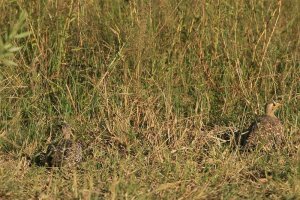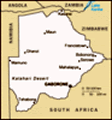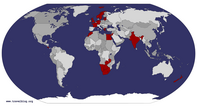Advertisement
Published: April 23rd 2008

 Sand Grouse
Sand Grouse
These little birds are very common but, as you see from the photo, are very difficult to spot. They will stay stock still until you are about to tread on them, at which point, they will fly into the air with as much commotion as befits such a small bird.After the theatrical entertainment of the previous evening, I was relieved that there was no second performance. The marula fruit remained fastened to the trees and the Clog Family von Genet kept their slippers on and rested. As such, I had a remarkably full night’s sleep, having hit the pillow at an extremely modest 21h30.
However, it was now 06h15 and the alarm hadn’t gone off. It was still dark but there were sounds. From the direction in which my feet were facing, the snuffling was alarming enough, but it was the low rumbles, sounds of breaking branches and general scary behaviour inches from my head that was my main worry. Peering into the gloom, I saw an elephant standing right outside my veranda, almost at the foot of my bed. I didn’t even need to guess what was making the sound by my head - I just hoped I wouldn’t do anything that would cause the larger elephant to do something rash and demolish the trees supporting my lodge!
I was definitely awake now so rose, attended to my needs, washed and even managed to dress myself without any adult supervision but I couldn’t leave the lodge due

 Impala
Impala
There were two groups of impala on this morning's walk. This was the harem of a very elegant male and, not far away, was a bachelor group. Apparently, one from this latter group will occasionally attempt to gain power over the harem, the ousted male having to get used to life in a different herd!to the unknown whereabouts of a pair of pachyderms. Straining my ears, I managed to convince myself that the only sounds were flora related and gingerly left my lodge.
Egged on by the turtle doves stressing the importance to “look HARder”, I did and decided that the rather noisy francolin were either stifling the sound of hiding elephants or there were none. Relieved, I made it to the main lodge, climbed the steps, ordered a pot of coffee and had my fill of the sesame seed snacks. Knowing that breakfast would be much later, I forced down a couple of spare!
By now, the routine of heading to the mekoro was becoming second nature and so it was that we found ourselves gliding silently across the carpeted water to our next wildlife adventure.
Having beached the mekoro, we headed along paths slicing through tall grass before being brought to a stop by Poison. Peering into the distance, we tried to spot the impala. Nothing. The Zebra? Nothing! Surely not a lion? No, not a lion! Down by our feet though was a couple of Sand Grouse! Not only were these birds very well camouflaged, they were also

 White Headed Vulture
White Headed Vulture
"What's that in that palm?", shouted Jill.
"Where?", we replied peering into the distance.
Binoculars out and we still couldn't see.
Finally, taking a photo at full zoom and then enlarging the image on the back of the camera yielded our results. A sharp-eyed Jill had spotted a White Headed Vulture, recently identified as a vulnerable species.remarkably statuesque. Even though we were standing almost on top of them, they were difficult to spot.
Moving on through the grass and leaving the grouse to graze, we were met by the beautiful sight of an Impala harem in the early morning sun. The dominant male was keeping an eye both on us and his harem and, as we shortly noticed, a second herd of bachelor impala. He was clearly concerned that his dominance may be called into question and had decided that we offered a lower threat. Consequently, we managed to get relatively near for the close-up shots.
Whilst we were gazing at the impala, Jill, my fellow Australian traveller, pointed out an object sitting in a distant palm tree. We had no idea whether it was a bird or simply a piece of tree. The binoculars were of little use but a judicial use of telescopic lens provided the answer - a White Headed Vulture. These are relatively rare birds and Poison was almost leaping about at this sighting.
We continued onwards with our quest to find lion. As bateleur circled overhead, we eventually came across another herd of impala
and a herd of

 Zebra and Impala
Zebra and Impala
This little foal didn't know it but it was acting to type. Zebra are surprisingly intelligent and closely shadow wildebeest, knowing that lions prefer the latter. I presume that, as there were no wildebeest in the vicinity, Impala was a useful substitute!zebra together. There was a maturing foal amongst the group, accompanied by an entourage of oxpeckers. The zebra didn’t appear to mind their passerine passengers, though I couldn’t tell whether the impala were also carrying additional luggage.
The sun was now getting serious about providing some heat and so we stopped to quench our thirst with the cool liquids that Colin had been relentlessly carrying in his little blue freezer box. The brief respite in animal spotting gave us all the opportunity to look at the wider vista. Bush and scrub were spread before us, intermingled with African Umbrella trees (or Thorn Acacia, to be more precise), palm trees and termite mounds; a paradise for the birds and animals that call this home.
By now, the sun was really showing who was boss and we’d also begun to head back towards our mekoro and breakfast. Jill’s keen eye once again spied a tiny bird, the Little African Bee Eater, perched on a Camel Thorn. We stood and watched as it waited, before launching at some unsuspecting insect before returning to its chosen branch, to repeat the whole saga again.
Animal sightings after that were scarce to say
the least. In a small clearing, we spotted some lion paw prints in the sand and identified a flattened area where something had slept overnight. We even stepped over some hyena droppings, but that was the only sighting we had of those animals.
Returning to our mekoro, the gentle journey back through the water-lilies was only disturbed by a delay at the lodge caused by a couple of elephant standing in the water and blocking our way. After some careful work in the rhythm section by Colin and Poison, the passive pachyderms were persuaded to peruse a different patch of papyrus, thus enabling us to return and feast upon lashing of bacon and egg - our belated breakfast.
Leaving the Magical Kingdom
Having enjoyed a breakfast with the squirrels, we retreated to our respective lodges to pack. Needless to say, my carrier bag didn’t require much attention and so I returned to the main lodge in short order and sat reading the various magazines and articles from the shelves.
Bidding our farewell to Amy (the host), we took our last trip across the water before arriving at the timber tree house that purported to be a terminal
building! Colin and Poison joined us as we carried our bags to the little airstrip where we were greeted by the sight of a slightly larger plane for our return trip. Larger but not newer! The BN-2 Islander first flew in 1965 and I wouldn’t be surprised if this particular one was about the same age! Still, there was little alternative and so we joined the locals and the nine of us made the trip back into Maun. Brian sat next to the pilot with clear instructions to keep his knees away from the controls - we didn’t mind looking at the elephants, impala and hippo from the air, but we certainly didn’t want to see them any closer than that!
Returning to terra firma, we taxied to a petrol pump and the pilot cut the engines. The ground crew rushed forward, each step being meticulously thought out as he brought forward his supermarket trolley which functioned as the baggage truck! Loading the few bags from the plane onto the trolley, we followed him across the apron into the terminal, where we were reunited with our guide, Alfred.
Journey to another Planet
Alfred had a beaming smile as

 Little Bee Eater
Little Bee Eater
This is the smallest African Bee Eater and, although nobody told this one, they are commonly seen in pairs or groups.
Clearly, this was a favourite perch and this little bird sat, watched, waited, launched, lunged, lunched and returned. Repeatedly.he shook our hands and welcomed us back to Maun. He’d declined to give too much away when he’d left us a couple of days previously, yet he was now engrossed in our experiences of the Delta. What was it like? Did we enjoy it? What were our thoughts? Did it surpass our expectations? What were our expectations? Questions, questions, questions - and we were all clamouring to provide the answers!
Alfred warned us that we had a 250km journey ahead of us to our next destination. He also warned us that we’d be passing through several Foot and Mouth zones. However, in anticipation of the night ahead, he’d also bought lots of meat of various types so that we could have a barbeque.
Stowing our luggage in the truck, we clambered aboard, taking up our previous seating positions and settled down for the journey. As we had heard no news about the results of the election in presidential elections in Zimbabwe, Alfred had purchased the Sunday Times. As we needed to cross the border at Kasane in a day or so, we really needed to understand whether that would indeed be a possibility or even how long

 Chief's Island
Chief's Island
Our camp was sited on the edge of Chief's Island, the interior of which was a mixture of scrub and bush, dotted with both palm trees and termite mounds.it could take.
Our departure from Maun was signalled by a large poster announcing that we’d missed a 24-hour Bimbo opportunity. To be honest, we’d actually eaten very well over the previous few days, so none of us was too upset. However, we were upset when we reached the next Foot and Mouth checkpoint.
Being instructed to stop, Alfred was asked to open the trailer. The rest of us took all our shoes and headed for the disinfectant matting. Alfred dutifully produced our meat for the barbeque and, expecting no further ado, was rather put out when instructed that the meat would have to be destroyed. We were not permitted to take it into the next zone. It was highly unlikely that the meat was in any way infected, but rules is rules and we needed to obey them. Reluctantly, Alfred did the right thing and disposed of our evening meal, completed all the resulting paperwork and drove forwards to pick us up.
As we continued, he was very philosophical commenting that this was Africa and they were only doing their job. We were not quite so philosophical pointing out that we were now without an evening

 Preparing the In-flight Catering
Preparing the In-flight Catering
We picked up our return flight in the early afternoon. As we arrived at the airstrip by mokoro, our plane flew in to land. Immediately, the ground crew went to work, one of the first items addressed was the in-flight catering!!!meal and we were still in the middle of the Kalahari!
Continuing across the desert, we eventually arrived in Gweta - “The Place of the Bullfrogs” - and were greeted by a sight very familiar to those from Australia and New Zealand - a giant version of something of local relevance, whether it be a Wellington Boot, a Kiwi Fruit or a 20 foot Carrot! For there, by the side of road, was a giant Anteater surreptitiously advertising the Kalahari Surf Club!
Being almost as far from the sea as you can be in Southern Africa, Alfred pulled off the road onto a sand track and we found ourselves in Planet Baobab, a grove of eight baobabs (approximately 4000 years old) and a number of traditional rondavels painted with traditional designs (approximately 4 years old).
Reaching our rooms, the immediate impression was one of darkness; the internal lighting wasn’t the most efficient, although I did eventually discover a second light switch which provided better lighting. Unpacking my carrier, I dragged a chair outside into the sun and sat relaxing in the last rays of the day.
As evening fell, I retired to the bar, in which

 Flight from the Okavango
Flight from the Okavango
Our return flight required a slightly larger aircraft than that of our inbound trip. In addition to the three of us, a number of locals were making a trip into Maun, bolstering the numbers.Alfred was already several bottles ahead of me. The centrepiece was a huge wrought iron chandelier comprising beer bottles underneath which we could relax in black and white cow skin chairs. We opted to prop the bar up!
Brian and Jill joined us a little later and, whilst we could still string words together, we headed to the table area for our evening meal. Not the world’s most delightful meal followed, but bearing in mind that we’d had our planned meal confiscated several hours previously, we were pleased to have had anything - nearly!
After the events of the day, my antipodean travellers retired to their lodge shortly after we’d exhausted the dining opportunities whilst Alfred and I returned to the bar to look into the possibility of a liquid dessert. The possibility turned into a certainty and the dessert turned into seconds, thirds and a number of recounts.
Having generally retired at 21h30 over the previous few evenings, it was with some surprise that Alfred and I were still talking and drinking at 22h30. Whether the words had any meaning though, we’d never know. Making our way to our individual lodges turned out to be a
very interesting and almost dangerous exercise as the path was very uneven and the lodges all looked the same. Even though the lodges were numbered, we couldn’t remember our numbers and even if we could, they weren’t obvious! I eventually found mine by peering into the shadows and checking the key worked in the lock!
Lighting the incense burners which would keep the mosquitoes away, I climbed into bed, crawled under the mosquito net and ensured it was all tucked in. There, in the light of my lamp, I watched the little insects crawl over the sheets and decided that there was little I could do! I smothered myself in mosquito repellent and snuggled down to a night on Planet Baobab.
Advertisement
Tot: 0.084s; Tpl: 0.014s; cc: 12; qc: 27; dbt: 0.0351s; 1; m:domysql w:travelblog (10.17.0.13); sld: 1;
; mem: 1.2mb














